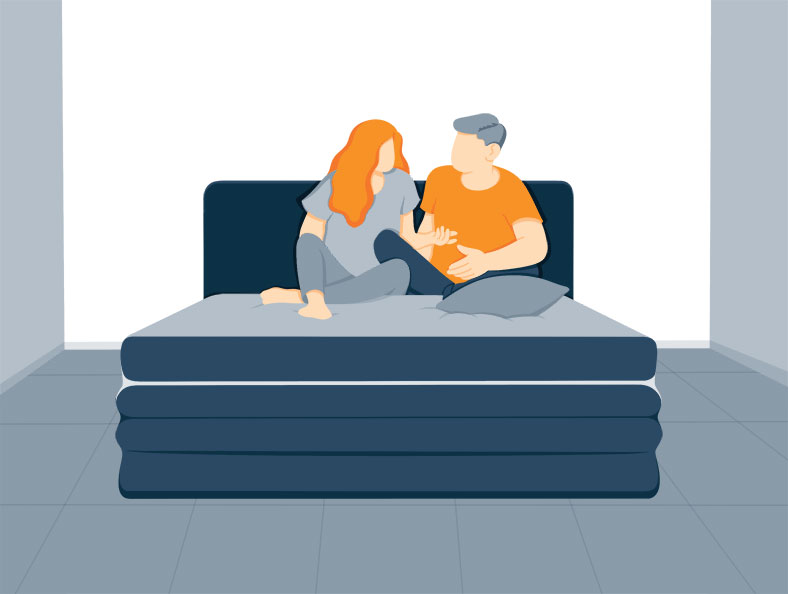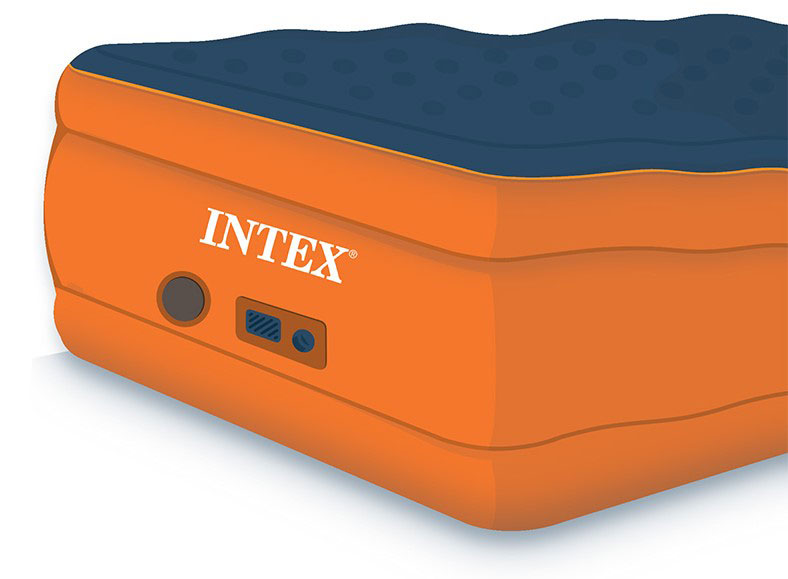Air mattresses provide convenient, easily storable solutions to give guests a comfortable place to sleep when they stay in your home or for you to use when camping. However, if you’re like many, you’ve probably had the same air mattress for many years and never cleaned it.
Unfortunately, blow-up beds are prone to collecting dirt and mold. Not cleaning them regularly could give them an unpleasant odor, create allergens, and affect your or your guests’ sleep quality.
In this guide, we’ll discuss how to clean an air mattress, why periodic cleaning of these beds is so important, and steps you can take to prevent mold growth.
Why You Should Clean Your Air Mattress
If you’ve never considered cleaning your air mattress before, you may wonder if regular cleaning is really necessary. However, routine cleanings are essential, as air mattresses can soil quickly from a range of contaminants.
Every time you set up your air mattress, it picks up dirt, dust, and hair from being on the floor. Additionally, when people sleep on your blow-up bed, they leave behind dead skin cells and sweat, which accumulate over time.
Finally, if you keep your air mattress in a closet or basement, it may be prone to mold and mildew growth there.
These contaminants all contribute to your mattress’s overall cleanliness.
Looking to buy a new one? Check out our guide for the best air mattresses on the market.
How to Prepare Your Air Mattress for Cleaning
Preparing your air mattress for cleaning is an important step. Let’s imagine that your guests have left after sleeping on your mattress during their week-long visit. Before you put your air mattress up for storage, you should clean it thoroughly. If you put it away dirty and plan to clean it later, you are more likely to forget, and any odors or moisture lingering on it may soak in or create conditions for mold or mildew.
Unplug It from the Power Source
Most modern air mattresses inflate with an electric pump that operates through a battery or a wall outlet. Before cleaning your mattress, be sure to unplug it from all power sources and distance it from any nearby outlets. If the pump is detachable, you should remove it from the bed to create better mobility while cleaning your air mattress.
If your air mattress includes a built-in pump, you’ll need to take caution to prevent any liquid from damaging the battery.
Remove All the Sheets
Next, you should remove any sheets, blankets, or coverings from the air mattress. We recommend throwing these in the washing machine while you proceed with cleaning the mattress itself.
Note: If you keep your air mattress set up at all times, you should wash its bedding at least once every few weeks. Because your air mattress sits on the ground, dust, dirt, and other particles can easily accumulate between the blankets over time.
Vacuum It
Finally, you should vacuum your mattress thoroughly to remove any external dust and dirt before washing it with a cleaning solution. We recommend keeping your mattress inflated while completing this step. If you deflate the bed, you may struggle to clean between the folds and creases.
To vacuum your air bed, slowly run the hose attachment down the mattress’s top material, being sure to cover every square inch. Next, move on to the sides of the mattress, then flip it over to vacuum the bottom.
What to Use for Cleaning an Air Mattress
Now that you’ve prepared your mattress, it’s time to gather your cleaning materials. The exact materials you need will depend on the type of cleaning you want to achieve.
- If you’re simply looking to complete a routine, thorough cleaning of a polyvinyl air mattress, we recommend using a solution of warm water with some dish soap.
- If you’re trying to remove human or cat urine from the bed, you will need vinegar and baking soda to eliminate odors.
- If you need to remove mold or mildew from the mattress, we recommend applying equal parts water and rubbing alcohol to any contaminated areas.
How to Wash an Air Mattress
Now it’s time to begin washing your air mattress. Whether you’d like to spot-clean or deep-clean your mattress, you’ll need to wash it by hand using a cloth dipped in your cleaning solution. You should never attempt to wash your air mattress in the washing machine unless its instructions explicitly state to do so.
Here is some more information about light cleaning, deep cleaning, and drying your blow-up bed.
Light Cleaning
If your air mattress features a velvety top layer, it’s best to only spot-clean stained areas to avoid damaging the material. You can follow these steps to spot-clean your mattress:
- Dip a washcloth or sponge into your cleaning solution and squeeze it out.
- Lightly dab any stains with the cloth, working from the edges of the stain toward the middle.
- Wet a clean cloth with water and blot the areas to remove any lingering soap.
- Repeat this process on all stains.
If gently scrubbing the stains with the cloth does not remove them, you can also try using a soft-bristle scrub brush.
Deep Cleaning
If your air mattress’s primary material is polyvinyl chloride or polyurethane plastics, you can feel confident in deep-cleaning it without damaging the material.
To perform a routine deep cleaning:
- Dip a clean cloth in your cleaning solution.
- Wring out the cloth to remove excess liquid.
- Wipe down the mattress with the cloth, using harsher pressure on any stained or excessively dirty areas.
- Use another clean, damp cloth to remove any extra soap.
To remove cat or human urine from the mattress:
- Gently blot the area with a dry cloth to absorb any urine.
- Sprinkle baking soda on the affected area and let it sit for several minutes before wiping it away.
- Combine equal parts of vinegar and water, then rub this solution into the soiled area.
- Repeat steps two and three until the urine stain is gone.
To remove mold or mildew from your air mattress:
- Dip a cloth in a solution of equal parts alcohol and warm water, wringing it out thoroughly.
- Scrub the moldy area with the cloth.
- Rinse the area using a cloth dipped in warm water.
- Spray the mattress with a fabric disinfectant to remove any lingering odor.
Drying Out Your Air Mattress
After washing it, the best and easiest way to dry your air mattress is to set it outside to air dry in the sun. However, if you’re experiencing cold or rainy weather, you can also place your bed near a fan to speed up the drying process.
If your mattress is a rubber or plastic material, it should air-dry relatively quickly. However, softer fabrics like velour and velvet may take several hours to dry thoroughly. Keeping the mattress inflated during the drying process can prevent moisture from accumulating within the folds and accelerate your drying time.
How to Prevent Mold or Mildew on Your Air Mattress
Preventing mold or mildew growth altogether can prolong the life of the mattress, saving you money. Here are a few tips to prevent mold on your air mattress:
- Dry your mattress entirely before storing it: After you wash your bed, you should be sure to dry it thoroughly before placing it in its storage location.
- Store the mattress in a well-ventilated location: We recommend storing your air mattress in a dry, well-ventilated area to prevent moisture from accumulating within the folds.
- Use a cover: If mold growth is a recurring problem, you may want to consider purchasing a vinyl zip cover. These covers are typically machine-washable, allowing you to clean them regularly to prevent mold and keep the mattress clean.
Conclusion
Routinely cleaning your air mattress is an essential step in creating a clean, contaminant-free environment for your guests. We recommend a deep cleaning of your airbed at least annually to keep it fresh—or more frequently as needed to remove body sweat, urine, or mold.
Thankfully, even deep-cleaning your mattress should only take you around 30 minutes, from start to finish. Better yet, the best mattress-cleaning supplies are materials you already have on hand, like baking soda, dish soap, and vinegar.
Once you incorporate this task into your regular cleaning schedule, your efforts will be well worth it to keep your mattress fresh, safe, and allergen-free.
Sources and References:
- [1] “Dampness and Mold at Home and at Work and Onset of Insomnia Symptoms, Snoring and Excessive Daytime Sleepiness”, Environment International, June 2020
Jill Zwarensteyn
Editor
About Author
Jill Zwarensteyn is the Editor for Sleep Advisor and a Certified Sleep Science Coach. She is enthusiastic about providing helpful and engaging information on all things sleep and wellness.
Combination Sleeper




